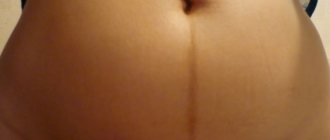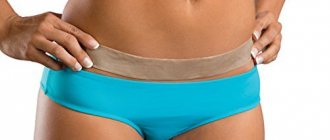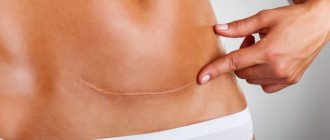Personal hygiene is of great importance in the life of every person. After a caesarean section, the body was weakened and went through stress.
Exposure to microbes on the skin and mucous membranes, as well as improper body care, can have consequences. Therefore, you need to know some of the features of care during this difficult period.
The postpartum period is a special time in a woman’s life. Lasts 6-8 weeks. It carries with it a lot of restrictions, especially if you had a cesarean section.
During this period, women in labor have a lot of questions about their condition and body care. One of the first questions: when can you take a bath after a cesarean section?
If you had a cesarean section, then in order to remove the baby, an incision was made in the anterior abdominal wall and uterus. All tissues were sutured, but scars remained, which take time to heal.
There is a suture on the anterior abdominal wall through which infection can enter the abdominal cavity and uterus if it is not cared for correctly.
Suture healing
It should be noted that modern obstetricians have stopped performing caesarean sections using old technologies - cutting the body longitudinally, which left a rough scar of a fairly large size. Thanks to the fact that an arched incision is now made above the pubis, it has become possible to hide the seams with underwear.
The answer to the question of how long it takes to wet the suture after a cesarean section will lie in what kind of technique the obstetricians used. The individual characteristics of the mother’s body also influence. The healing time will be determined by the thickness of the fatty tissue and care of the incision after surgery.
As a rule, the wound heals 7-10 days after surgery. And doctors answer positively to the question whether it is possible to wet the suture after a cesarean section at least a week after birth.
In cases where everything is in order, mother and child are discharged from the hospital 5 days after the operation. Throughout this time they are under close medical supervision. They are the ones who care for scars and monitor the dynamics of their healing. Doctors also remove the threads used to close the incisions.
Possible complications
Caesarean section is a serious operation during which the integrity of the skin, muscle, abdominal tissue, and uterine wall is disrupted. Problems with the suture can occur both in the first weeks after birth, during healing, and several years later. Depending on the time of their appearance, early and late complications are distinguished.
Early complications:
- hematoma or bruising. Most likely, the damaged blood vessels were poorly sutured during the operation. The reasons may be careless change of dressing, improper treatment, and premature removal of sutures when a fresh wound is again mechanically affected;
- seam divergence. Occurs quite rarely, usually within 1-2 weeks after surgery. The seam may crack, come apart at the edge or completely along its entire length. Perhaps an infection has entered the tissue and is preventing fusion. Another option is that the woman in labor lifted weights and was actively engaged in physical labor;
- redness and inflammation of the suture. May occur due to inadequate care or infection of the wound.
Conditions are especially dangerous when the suture festers, diverges, bleeds, or swells. This may increase your body temperature, which indicates infection. It is necessary to urgently consult a doctor. As a rule, anti-inflammatory drugs and antibiotics are prescribed in the form of ointments and tablets. If the case is advanced, additional surgical intervention may be required, which will negatively affect the aesthetics of the scar.
After the second cesarean, on the 4th day they removed the bandage and allowed me to go to the shower, it was still in the RD... after the shower I pulled on my panties, sorry, I completely forgot that I needed to distribute them below the seam... in general, the fabric stuck safely to the seam, and I removed it I pulled it as hard as I could when I went to the toilet and as a result, the stitch was turned out in a couple of places, nothing was wrong, it was treated, and I was discharged from the CS on the 7th day. At home, the seam got a little wet, I smeared it well with green paint, went to bed - I didn’t specifically cover it with anything so that it could be blown with air, it healed in 5-7 days
Olga Mladenova
https://deti.mail.ru/forum/v_ozhidanii_chuda/rody/gnoitsja_shov_posle_kesarevo/?page=2
...I went to the surgeon, they pulled out a 4 cm thread, after a week of dressings with levomekol and potassium permanganate, everything tightened up!
Julia
https://www.baby.ru/blogs/post/37006209–14907231/
Late complications:
- ligature fistulas. This phenomenon appears months after surgery. The tissue in the area of the threads that sew the blood vessels becomes inflamed. Swelling, nodular compaction, redness, and then suppuration appear. The body rejects the suture material. Treatment with medications is ineffective; surgical removal of the fistula is required;
- hernia. It is formed quite rarely, with a vertical seam or the presence of several seams from different operations. A protrusion appears in the suture area, accompanied by painful sensations. The hernia is removed by surgical dissection;
- keloid scar. This complication is only aesthetic in nature and does not pose any harm to health. The tissue damaged during the operation may grow unevenly, resulting in a wide, rough suture. You can try to eliminate this complication using conservative methods: using ointments, creams, laser, ultrasound, liquid nitrogen. Surgical excision of the scar is considered the most effective.
When can you wash?
Despite the fact that a woman in labor can wash herself a day after a cesarean section, such permission only applies to certain areas of the body. The doctor, explaining whether it is possible to wet the suture after a cesarean section, will definitely inform the patient that under no circumstances should this be done immediately after the operation. Before water gets on the scar, the stitches must be removed. And they are removed after 5 days. It is also necessary that the scar becomes airtight and it is impossible to introduce any infection through it. Such conditions are achieved 7-10 days after the incision.
Today, for additional security, pharmacies sell special plasters that do not allow moisture to enter the wound. This makes showering safer. It will be best if the patch is applied directly by a nurse or doctor.
Precautionary measures
The area around the seam should be gently washed with the palm of your hand and a small amount of soap or intimate hygiene gel. The scar itself can be wetted only after the stitches are removed. For the first time after taking water procedures, it is necessary to blot the seam dry with a clean, dry towel and treat it as prescribed in the maternity hospital.
It is important to carefully monitor the condition of the suture and in case of any deviations, for example, bleeding, divergence of edges, discharge, consult a doctor as soon as possible.
When can you take a bath?
Women who like to take a bath especially ask themselves the question of when to wet a suture after a caesarean section. During pregnancy, this pleasant procedure is prohibited: taking a bath can trigger premature birth.
Also, in any case, the stomach gets wet, which means that after the operation you will also need to continue to deprive yourself of this pleasure. Also, for 6 weeks after surgery, the female body continues to release blood from the genital tract. This is called lochia. And this is also one of the reasons why it will be impossible to go to the bath after a cesarean section.
Regardless of what the doctor says regarding when you can wet the suture after a cesarean section, it is highly not recommended to take a bath earlier than 2 months after birth. After all, there is a high risk that uterine bleeding will simply open, and this is deadly.
What could be the consequences?
Often women take it upon themselves to determine for themselves when they can bathe in the bathroom after a caesarean section. Neither doctors nor anyone else has the right to interfere with this decision, since control over the patient’s condition and responsibility for it in the postpartum period is borne and carried out, first of all, by herself. Let us briefly outline the consequences of such a rash step:
- A scar that gets wet as a result of water treatments will take a very long time to heal. It is even possible that the wound will become suppurated, which means that at least long-term treatment will be required, and at maximum a repeat operation will be required to eliminate the consequences.
- Microorganisms and bacteria that live in water can enter the uterus through an unhealed suture, causing inflammation and infection.
- Hot water will inevitably increase the intensity of lochia, which can result in bleeding.
- Due to the fact that the mother’s immunity (especially after cesarean section) is very weak, it is necessary to exclude factors that can provoke postpartum complications. Bath is one of them.
The above list is far from complete. In fact, there are many more negative aspects caused by ignoring the doctor’s recommendations. And you should think several times before following your own desires, neglecting numerous risks, especially when it comes to your own health.
When can you go to the pool?
A modern woman after giving birth tries to get her body back into its previous shape as soon as possible. And swimming helps to do this in many ways - it makes the skin elastic again, promotes weight loss, restores vitality, without overloading the body weakened by childbirth.
But there is a limitation here too. A woman after a caesarean section will be able to go to the pool no earlier than 2 months after the operation. The whole point is not the danger of becoming infected with anything, but the fact that the body simply will not be ready for such a load. The woman will only be shown walks and simple exercises. The level of physical activity can only be increased gradually.
How long can you take a bath?
How long can you take a bath after a caesarean section without risking your health? When the stitches have just begun to heal, you should not spend more than 5-7 minutes in the bath. No matter how much you would like to lie in warm water, you will have to endure such “inconveniences” for some time - this is for your own safety.
When the wound heals and the tissues recover from the injury, you can swim for 20 minutes or more. As the body recovers after cesarean section, you can gradually increase the temperature of the water, bringing it to optimal (at your discretion) levels.
When can you swim in the sea?
Those who are going to sea are often concerned about the answer to the question of when can a suture be wetted after a caesarean section. But the beaches are dangerous for anyone with weakened immune systems. And of course, a woman after such an operation is at risk. Any infection easily attacks the body that has undergone complex procedures. The stitches may come apart, suppuration may begin, and this will lead to death.
So a woman cannot go to the sea even 2 months after the operation. It will also be dangerous. You should avoid open water for at least six months after a caesarean section.
When should you plan your next pregnancy after a caesarean section?
After a cesarean section, a scar remains on the uterus. In order for this scar to “withstand” the next pregnancy and childbirth, it must be strong - that is, contain enough muscle and elastic fibers to withstand stretching during fetal growth and remain strong enough during labor pains.
The condition of the uterine scar is determined using a specialized examination and occurs in each woman at an individual time. However, in each specific case, before planning your next pregnancy, you must consult your doctor.
Choice
Because of these restrictions, particularly regarding when the suture can be wetted after a caesarean section, a woman's choice of how the birth will be carried out is important. At the moment, it’s hard to say what will be easier for her – natural childbirth or surgery. In the first case, the body experiences extreme stress, this often leads to an exacerbation of all kinds of diseases, death, but the recovery will be easier: a whole 2 days earlier, the mother will be back at home. In the second case, the recovery will take longer.
But it must be borne in mind that even during natural childbirth, doctors often make an incision - an episiotomy. And such seams will also require care; this will also lead to many restrictions and prohibitions that will greatly disrupt the usual way of life.
So in any case, childbirth for a woman is a difficult ordeal, which will result in many hardships and risks. When making a choice, it is necessary to take into account the hereditary factor: how quickly did the sutures heal in relatives?
It is impossible to violate the doctor’s recommendations, and if a woman goes into the shower after removing the bandages applied by specialists, she will not be able to wipe the seam dry, it will be very painful to do so. And humidity creates a favorable environment for the proliferation of a large number of harmful bacteria. If the seam accidentally gets wet, you must immediately inform your doctor. In this case, a dressing will be needed. At first, after a shower, it is recommended to treat the seam with brilliant green.
Should I wet the suture after surgery?
Let us answer this question in a detailed and reasonable manner. Every woman in labor who has given birth to a baby through a cesarean operation dreams that the scar on her stomach, if not completely disappeared, would be barely noticeable. It is quite possible to achieve an optimal cosmetic effect if 4 conditions are met:
- Ideally smooth wound edges.
- Proper blood supply to the area where the wound is located (in this case, the anterior abdominal wall).
- Good heredity (no tendency to form keloids).
- Sterility.
Compliance with the first three points, unfortunately, is not in our control; a lot here depends on both the surgeon and genetics. But it is quite possible to ensure the fulfillment of the fourth condition independently. The postpartum suture must be regularly treated with iodine, alcohol or brilliant green (it is better to check this point with your doctor), the sterile dressing must be changed at least every other day. It is better if this is done by a nurse or doctor in a room specially designated for dressings, where the air is regularly quartzed.
Important! It is prohibited to remove the bandage from the seam yourself before/after dressing!
When you can swim after a cesarean section directly depends on maintaining the sterility of the scar - only after the doctor allows you to remove the bandage. By removing it without permission and going to the shower, a woman creates ideal conditions for various bacteria to enter the wound and multiply there. After all, warmth and moisture are the latter’s best friends. No matter how much you want, it is impossible to wipe the scar dry. The first thing that will prevent this is pain, tingling and discomfort. As a result, the threads that were used to connect the skin during the operation will swell, and microbial inflammation will not have to wait long. Therefore, until the stitch has completely healed, swimming in the shower, and especially in the bathroom, is taboo. It is allowed during this period (it usually does not last long - 5-7 days) to wash the body, but carefully protect the area around the wound. After this period, you will be able to take a shower (not a bath!) with your doctor’s permission.
Attention! It is imperative to inform the nurse or doctor if the suture is accidentally wet. You may be prescribed additional procedures or dressings.
What you should pay attention to
A specialist will be able to determine when a woman in labor can bathe based on a detailed examination of the condition of the scar. You may need to undergo additional tests to detect inflammation in the body.
However, even when it is already possible to take a bath after a caesarean section, a woman needs to take into account a number of important recommendations.
- Before bathing, the bath should be thoroughly washed with a disinfectant and rinsed with cold water.
- For the first few days, it is better to use boiled water for washing, which contains various bacteria in a much smaller volume than raw water.
- The water should not be hot, maximum 40-45 degrees. Otherwise, blood circulation increases significantly, which entails a slowdown in the process of tissue regeneration and.
- You need to forget about sea salt, flavored balls and foam for a while. Natural soap and chamomile decoction are the best “companions” for a young mother when performing hygiene procedures.
- It is better to wait with prolonged relaxation in the bath; the procedure should not last longer than 5–7 minutes.
It is also worth considering that hot and even well-warm water enhances. Therefore, it is better not to postpone bathing until the evening to avoid stagnation of milk in the mammary glands.
Afterword
A caesarean section is a very serious operation, after which a woman’s life is temporarily divided into “possible” and “impossible”. No matter how much young mothers argue that water procedures will not cause harm, practice shows the opposite.
Neglecting the gynecologist’s recommendations is fraught with serious complications, but now the woman is responsible not only for herself, but also for her newborn baby! Therefore, you should not take risks - it is better to wait until the favorable time comes to return to the previous rhythm of life. Temporary refusal to take a bath is a necessary precaution, which, however, will help maintain the health of the new mother.
The postpartum period is another serious test that every woman who gives birth to a baby must go through. Especially if the birth took place via caesarean section. In addition to questions about feeding, swaddling and overall care of the baby, and the mother’s recovery after surgery, a large number of problems need to be solved. One of them is the personal hygiene of the mother in labor.
So, a bath after a caesarean section - is it necessary, do doctors allow such water procedures, what should a woman who has undergone surgery take into account when performing body care procedures. This and many other things that are important for a new mother are discussed further in the article.
What do doctors think?
Gynecologists recommend, or rather, insist that a woman after a cesarean section is required to consult with a specialist on any controversial issue when it comes to her own well-being. After all, even such a seemingly necessary hygienic procedure as a bath after a caesarean section, when it occurs at the wrong time and incorrectly, can cause irreparable damage to a fragile body.
Let’s quote the leading obstetrician-gynecologist of the Moscow PMC Elena Avdeeva: “The first thing patients ask me when leaving the maternity hospital is whether they can take a bath. Of course, if a woman gives birth naturally and without complications, after a week or two she can lie in the bath for hours, the main thing is that the temperature of the water and its purity (first of all) meet the standards. As for patients who have undergone cesarean section, here I, like all doctors, recommend holding off on full-fledged water procedures. This is, after all, an operation, although it is common today. It’s better to take all precautions so that after a couple of months you can lead a full and, most importantly, healthy life, fully enjoying the joy of motherhood.”









